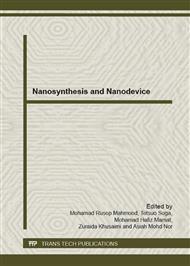[1]
A. Mallikarjuna Reddy, A. Sivasangkar Reddy, P. Sreedhara Reddy, Effect of substrate bias voltage on the physical properties of dc reactive magnetron sputtered NiO thin films, J. Material Chemistry and Physics 125 (2011) 434-439.
DOI: 10.1016/j.matchemphys.2010.10.035
Google Scholar
[2]
Hongwei Zhang, zhanjun Zhang, jingjian Li, shengmin Cai, Effect of direct current bias voltages on supported bilayer lipid membranes on a glassy carbon electrode, Electrocheministry Communications 9 (2007) 605-609.
DOI: 10.1016/j.elecom.2006.10.026
Google Scholar
[3]
S. Gangopadhyay, R. Archarya, A.K. Chattopadhyay, S. Paul, Effect of substrate bias voltage on structural and mechanical properties of pulsed DC magnetron TiN-MoSx composite coatings, Vacuum 84 (2010) 843-850.
DOI: 10.1016/j.vacuum.2009.11.010
Google Scholar
[4]
L.B. Zang, M.H. Tang, J.C. Li, Y.G. Xiao, Effects of applied bias voltage in tunnel junctions with ferroelectric barrier, Solid-State Electronics 68 (2012) 8-12.
DOI: 10.1016/j.sse.2011.09.005
Google Scholar
[5]
E. Cappelli, S. Orlando, G. Mattei, S. Zoffoli, P. Ascarelli, SEM and raman investigation of RF plasma assisted pulse laser deposited carbon films, Applied Surface Science 19 (2002)452-457.
DOI: 10.1016/s0169-4332(02)00362-8
Google Scholar
[6]
O. S. Panwar, Ishpal, R. K. Tripathi, A. K. Srivastava, Mahesh Kumar, Sushi Kumar, Effect of substrate bias in hydrogenated amorphous carbon films having embedded nanocrystallites deposited by cathodic jet carbon arc technique, J. Diamond & Related Materials 25 (2012).
DOI: 10.1016/j.diamond.2012.02.010
Google Scholar
[7]
Xiaoqiang liu, Jun Yung, Junying Hao, Jianyun Zheng, Qiuyu Gong, Weimin Liu, Microstructure, mechanical and tribological properties of Si and Al co-doped hydrogenated amorphous carbon films deposited at various bias voltages, Surface % Coating technology 206 (2012).
DOI: 10.1016/j.surfcoat.2012.04.006
Google Scholar
[8]
Peng Wang, Xia Wang, Youming Chen, Guangan Zhang, Weimin Liu, Junyan Zhang, The Effect of applied negative bias voltage on the structure of Ti-doped a-C: H films deposited by FCVA, Applied Surface Science 253 (2007) 3722-3726.
DOI: 10.1016/j.apsusc.2006.08.003
Google Scholar
[9]
J.G. Buijnsters, M. Camero, L. Va' Zquez, F. Aqullo'-Rueda, C. Go' Mez-Aleizandre, J.M. Albella, DC substrate bias effects on the physical properties of hydrogenated amorphous carbon grown by plasma-assisted chemical vapour deposition, Vacuum 81 (2007).
DOI: 10.1016/j.vacuum.2007.04.021
Google Scholar
[10]
I. Ahmad, S.S. Roy, P.D. Maguire, P. Papakonstantinou, J.A. McLaughlin, Effect of substrate bias voltage and substrate on structural properties of amorphous carbon films deposited by unbalanced magnetron sputtering, Thin Solid Films 482 (2005).
DOI: 10.1016/j.tsf.2004.11.158
Google Scholar


